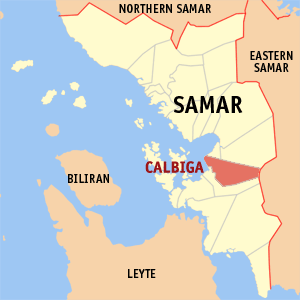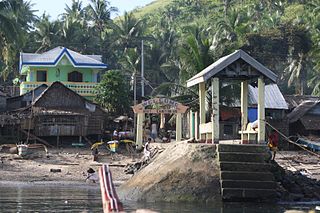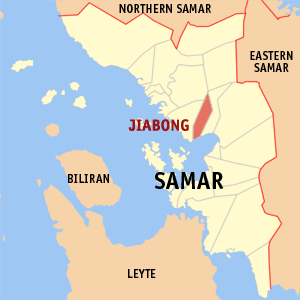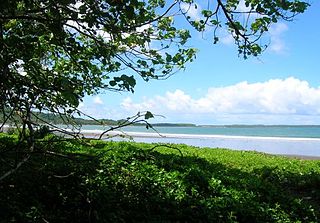
Samar, formerly named as Western Samar, is a province in the Philippines located in the Eastern Visayas region. Its capital is the city of Catbalogan. It is bordered by Northern Samar, Eastern Samar, Leyte and the Leyte Gulf, and includes several islands in the Samar Sea. Samar is connected to the island of Leyte via the San Juanico Bridge.

Balangiga, officially the Municipality of Balangiga, is a 4th class municipality in the province of Eastern Samar, Philippines. According to the 2015 census, it has a population of 14,085 people.

Babatngon, officially the Municipality of Babatngon, is a 4th class municipality in the province of Leyte, Philippines. According to the 2015 census, it has a population of 27,797 people.

Catarman, officially the Municipality of Catarman,, is a 1st class municipality and capital of the province of Northern Samar, Philippines. According to the 2015 census, it has a population of 94,037 people.

Calasiao, officially the Municipality of Calasiao, is a 1st class municipality in the province of Pangasinan, Philippines. According to the 2015 census, it has a population of 95,154 people.

Barugo, officially the Municipality of Barugo, is a 4th class municipality in the province of Leyte, Philippines. According to the 2015 census, it has a population of 32,745 people.

Calbiga, officially the Municipality of Calbiga, is a 4th class municipality in the province of Samar, Philippines. According to the 2015 census, it has a population of 22,982 people. The town is famous for the Langun-Gobingob Caves which is the largest cave system in the Philippines, reputed to be the second largest in Asia and the world's third largest karst formation.

Daram, officially the Municipality of Daram, is a 3rd class municipality in the province of Samar, Philippines. According to the 2015 census, it has a population of 42,879 people.

Jiabong, officially the Municipality of Jiabong, is a 5th class municipality in the province of Samar, Philippines. According to the 2015 census, it has a population of 18,342 people.

San Sebastian, officially the Municipality of San Sebastian, is a 6th class municipality in the province of Samar, Philippines. According to the 2015 census, it has a population of 8,057 people.

Tarangnan, officially the Municipality of Tarangnan, is a 4th class municipality in the province of Samar, Philippines. According to the 2015 census, it has a population of 24,992 people.

Zumarraga, officially the Municipality of Zumarraga, is a 5th class island municipality in the province of Samar, Philippines. According to the 2015 census, it has a population of 16,295 people.

Allen, officially the Municipality of Allen, is a 5th class municipality in the province of Northern Samar, Philippines. According to the 2015 census, it has a population of 25,469 people.

Lope de Vega, officially the Municipality of Lope de Vega, is a 4th class municipality in the province of Northern Samar, Philippines. According to the 2015 census, it has a population of 14,687 people.

Palapag, officially the Municipality of Palapag, is a 3rd class municipality in the province of Northern Samar, Philippines. According to the 2015 census, it has a population of 34,286 people.

Caramoan, officially the Municipality of Caramoan, is a 2nd class municipality in the province of Camarines Sur, Philippines. According to the 2015 census, it has a population of 47,605 people.

Borongan, officially the City of Borongan, is a 4th class city and capital of the province of Eastern Samar, Philippines. According to the 2015 census, it has a population of 69,297 people.

Pastrana, officially the Municipality of Pastrana, is a 5th class municipality in the province of Leyte, Philippines. According to the 2015 census, it has a population of 18,002 people.

Catbalogan, officially the City of Catbalogan, is the capital of the province of Samar, Philippines. According to the 2015 census, it has a population of 103,879 people.

Eastern Visayas is an administrative region in the Philippines, designated as Region VIII. It consists of three main islands, Samar, Leyte and Biliran. The region has six provinces, one independent city and one highly urbanized city namely, Biliran, Leyte, Northern Samar, Samar, Eastern Samar, Southern Leyte, Ormoc and Tacloban. The highly urbanized city of Tacloban is the sole regional center. These provinces and cities occupy the easternmost islands of the Visayas group of islands.






















